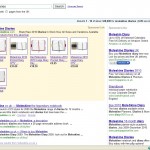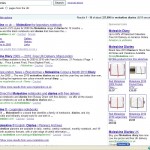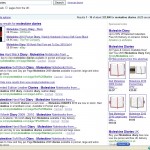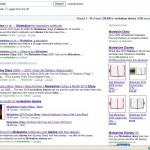- Image 1
- Image 2
- Image 3
- Image 4
As explained in ‘The ever changing world of Google’ blog post, a thorough understanding of Google and how it operates is critical to our work.
Having discovered recent changes implemented by Google, the team at Gillissa decided to experiment further within the Google search page, using the Google Product Extension capability (formerly known as the Google Plus Box).
To enhance the explanation of our findings, we have included images of our research.
Image 1 illustrates a standard Google Product Extension advert in operation, in this scenario occupying the highest position within the sponsored links section. There you can see six images of moleskine diaries, showing part of the stock that the company, Simply Moleskine, offers to the consumer.
Surprisingly, an advert that is top of the sponsored links with, or without, Google Product Extension capabilities can move dramatically, by selecting different categories within the standard results pages options.
For instance, Image 2 shows selecting ‘fewer shopping sites’ removes the sponsored links adverts above the organic search results altogether. You will notice how the Simply Moleskine advert now occupies a position within the sponsored links section, as visually effective as before yet lacking the prime position it once occupied. Also notice that the organic search results offer descriptive text on Moleskine diaries, as opposed to prices and products. Google has effectively removed all shopping sites in accordance with the users’ request when they selected ‘fewer shopping sites’.
By selecting ‘more shopping sites’, shown in Image 3, the layout is similar to the ‘fewer shopping sites’ page, in that the sponsored links occupy the right-hand side of the page only. However, again in accordance with the user’s request, the organic search results show a variation of descriptions and prices from shopping sites. Furthermore, Simply Moleskine did not feature within the organic search results in previous searches, however now occupies a first page position, perhaps due to the fact that it is more relevant to the users query, ‘moleskine diary from more shopping sites’. The rise in organic search position and Product Extension capability means that Simply Moleskine in effect dominates the first page results.
Interestingly, Image 4 shows selecting the ‘standard results’ link after selecting either of the other two links does not completely amend the results back to their initial standing (See Image 1). Though the organic search results revert back to express a balance of shopping sites and non-shopping sites, the format of the page layout is similar to that of images 2 and 3, rather than the original page layout (image 1).
To conclude it appears that the location of a Google Product Extension on a search results page can change dramatically dependent on what searching option the user chooses to operate in. However, as Images 1 and 3 shows, the Google Product Extension can dominate a search page, enhancing the possibility of a user being drawn to an advertiser’s website through their advert.





